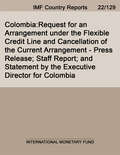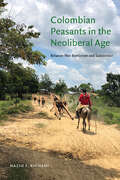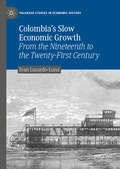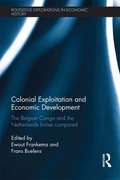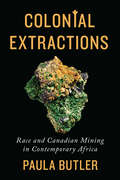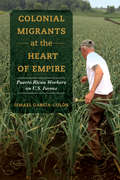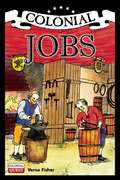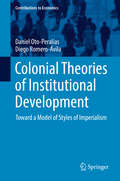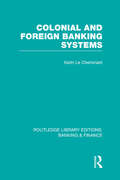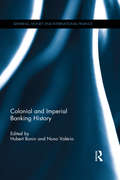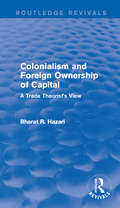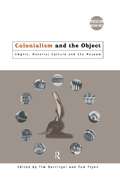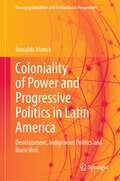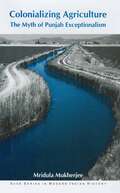- Table View
- List View
Colombia's 4G Road Program: The Pacifico 3 Bond Offer
by Maria Fernanda Miguel John D. Macomber Mariana CalColombia conceived its 4G (Fourth Generation) Road Program to try to attract $17 billion from the private sector for investment in toll roads. The nation had also created the National Infrastructure Agency of Colombia (ANI) to oversee multiple investments, and the National Development Fund (FDN) as a credit enhancement vehicle. By 2017, Colombia had largely recovered from the "bad times" and was viewed as one of Andean Nations' success stories. Colombia was rapidly expanding its seaports, airports, power grid, and, particularly, its road network to link multiple metropolitan and rural areas across its mountain-riddled territory. Private-public partnerships were used since the federal budget did not have enough cash flow or credit to fund a vast road building program. The 4G Program featured improvements as compared to earlier-generation programs, making it more attractive to private investors. These included newly crafted contracts, shared risks between private and public parties, and liquidity lines of credit provided by FDN.
Colombia: An Economic Premium to Peace?
by Richard H.K. VietorColombia, once the fastest growing country in Latin America, continues to struggle with productivity. Both labor productivity and total factor productivity have been low for the past decade, despite economic growth of 4.7% annually. Many factors contribute, which President Duque, and President Santos before him, have tried to address. But now, however, President Duque has even larger institutional problems to solve-implementation of the peace treaty, dealing with Venezuelan refugees and COVID-amidst a macroeconomic and political crisis induced by the pandemic.
Colombia: Financial System Stability Assessment (Imf Staff Country Reports #No. 13/50)
by International Monetary Fund. Monetary and Capital Markets DepartmentA report from the International Monetary Fund.
Colombia: Request For An Arrangement Under The Flexible Credit Line And Cancellation Of The Current Arrangement-press Release; Staff Report; And Statement By The Executive Director For Colombia (Imf Staff Country Reports)
by International Monetary Fund. Western Hemisphere Dept.A report from the International Monetary Fund.
Colombia: Selected Issues
by International Monetary FundA report from the International Monetary Fund.
Colombia: Strong Fundamentals, Global Risk
by Jonathan Schlefer Aldo Musacchio Richard H.K. Vietor Carolina CamachoBy mid-2009 Colombian President Alvaro Uribe had ended decades of virtual civil war and strengthened the business climate, but he faced tough economic challenges. Though he had instituted prominent market reforms and brought inflation down sharply, Colombia seemed stuck in a middle ground, industrially behind Brazil or Chile but ahead of poorer Latin American countries. Traditional exports--coal, coffee, oil--still comprised more than half the total, while manufactured exports comprised only a fifth. Public investment in transport and other infrastructure--a perpetual obstacle to growth in mountainous Colombia--remained too low. A major ambition of Uribe or his possible like-minded successor was to secure U.S. Congressional approval of a free trade agreement signed in 2006. But would it really help Colombia diversify its economy? Colombia already had access to the U.S. market but still had a relatively closed economy compared with neighbors such as Mexico or Chile.
Colombian Peasants in the Neoliberal Age: Between War Rentierism and Subsistence
by Nazih F. RichaniPresenting the historical, socioeconomic, political, and security conditions experienced by three peasant communities, Colombian Peasants in the Neoliberal Age provides readers with the most up-to-date and comprehensive assessment of Colombia's peasants currently available. Nazih F. Richani examines their adaptive strategies and resistance to subsumption processes and the prospects for the sustainability of their modes of production, culture, and livelihood. In addition, he explores each communities' level of agency that has allowed them to respond to the encroachments of rentier economy by devising adaptive strategies and building collaborative networks, forging new partners at the national, regional, and global levels. These findings are timely given the historic change in Colombia's leadership as represented by President Gustavo Petro, a former rebel and a leftist leader, and his vice president Francia Elena Marquez, an Afro-Colombian woman activist. The Petro administration offers an exceptional opportunity for radical policy change toward national development, particularly towards peasants and agrarian issues. The research undertaken in this book holds the potential to enrich political discussions and inform new policies.
Colombia’s Slow Economic Growth: From the Nineteenth to the Twenty-First Century (Palgrave Studies in Economic History)
by Ivan Luzardo-LunaLooking at the years 1870-2016, this book analyses the reasons behind Colombia’s chronically slow economic growth. As a comparative economic history, it examines why Colombia has seen lower growth rates than countries with similar institutions, culture and colonial origins, such as Argentina in 1870-1914, Mexico in 1930-1980, and Chile from 1982 onwards.While Colombia's history has shown relative macroeconomic stability, it has also shown a limited capacity for integrating into the world economy and embracing technological breakthroughs compared to the rest of the world, including steam, mass production and Information Technology. This volume thus moves away from the long-held view that institutional path dependence is the main determinant of differences in long-run economic growth across countries.
Colonel Sanders and the American Dream (Discovering America)
by Josh OzerskyThe James Beard Award–winning food writer serves up &“a quirky and rewarding exploration of a &‘very real time, place, product, and person&’&” (TriQuarterly). Among the most recognizable corporate icons, only one was ever a real person: Colonel Sanders of Kentucky Fried Chicken/KFC. From a 1930s roadside café in Corbin, Kentucky, Harland Sanders launched a fried chicken business that now circles the globe, serving &“finger lickin&’ good&” chicken to more than twelve million people every day. But to get there, he had to give up control of his company and even his own image, becoming a mere symbol to people today who don&’t know that Colonel Sanders was a very real human being. This book tells his story of a dirt-poor striver with unlimited ambition who personified the American Dream. Acclaimed cultural historian Josh Ozersky defines the American Dream as being able to transcend your roots and create yourself as you see fit. Harland Sanders did exactly that. At the age of sixty-five—after failed jobs and misfortune—he packed his car with a pressure cooker and his secret blend of eleven herbs and spices and began peddling the recipe for &“Colonel Sanders&’ Kentucky Fried Chicken&” to small-town diners. Ozersky traces the rise of Kentucky Fried Chicken from this unlikely beginning, telling the dramatic story of Sanders&’ self-transformation into &“The Colonel,&” his truculent relationship with KFC management as their often-disregarded goodwill ambassador, and his equally turbulent afterlife as the world&’s most recognizable commercial icon. &“Nobody finishing this book will look at their local KFC in the same way again.&” —The National
Colonial Broadcasting Co.
by George WuColonial Broadcasting, a major American television network, must determine whether fact-based television movies garner higher Nielsen ratings than movies based on fictional concepts. Furthermore, the network must decide whether to accept a fixed-fee advertising contract or a sliding-scale contract.
Colonial Exploitation and Economic Development: The Belgian Congo and the Netherlands Indies Compared (Routledge Explorations in Economic History)
by Ewout Frankema Frans BuelensSince many countries in the world at present were European colonies in the not so distant past, the relationship between colonial institutions and development outcomes is a key topic of study across many disciplines. This edited volume, from a leading international group of scholars, discusses the comparative legacy of colonial rule in the Netherlands Indies and Belgian Congo during the nineteenth and twentieth centuries. Whereas the Indonesian economy progressed rapidly during the last three decades of the twentieth century and became a self-reliant and assertive world power, the Congo regressed into a state of political chaos and endemic violence. To which extent do the different legacies of Dutch and Belgian rule explain these different development outcomes, if they do at all? By discussing the comparative features and development of Dutch and Belgian rule, the book aims to 1) to contribute to a deeper understanding of the role of colonial institutional legacies in long run patterns of economic divergence in the modern era; 2) to fill in a huge gap in the comparative colonial historical literature, which focuses largely on the comparative evolution of the British, French, Spanish and Portuguese Empires; 3) to add a focused and well-motivated comparative case-study to the increasing strand of literature analyzing the marked differences in economic and political development in Asia and Africa during the postcolonial era. Covering such issues as agriculture, manufacturing and foreign investment, human capital, fiscal policy, labour coercion and mineral resource management, this book offers a highly original and scholarly contribution to the literature on colonial history and development economics.
Colonial Extractions
by Paula ButlerChallenging Canada's image as a humane, enlightened global actor, Colonial Extractions examines the troubling racial logic that underpins Canadian mining operations in several African countries. Drawing on colonial, postcolonial, and critical race theory, Paula Butler investigates Canadian mining activities and the discourses which serve to legitimate this work.Through a series of interviews with senior personnel of businesses with mining operations in Africa, Butler identifies a continuation of the same colonialist mindset that saw resource ownership and racial dominance over Indigenous peoples in Canada as part of Canada's nation-building project. Financially, culturally, and psychologically, Canadians are invested in extracting resource-based wealth in the Global South, and - as Butler's analysis of Canada's influence over South Africa's first post-apartheid mining legislation shows - they look to legitimize that extraction through neoliberal legal frameworks and a powerful national myth of benevolence.Complementing analyses of the industry through political economy or critical development studies, Colonial Extractions is a powerful and unsettling critique of the cultural dimension of Canada's mining industry overseas.
Colonial Heritage and the Socio-Economic Development of Africa
by Carol Chi Ngang Emeka C. Iloh Denis Nfor YuniThis book examines the influence of prevailing colonial heritage in Africa on its socio-economic development. Colonisation of Africa and resulting agreements have shaped economic, political, educational, and health landscapes that have, in turn, affected continental economic development. In revisiting the question of independence from a comprehensive and transdisciplinary perspective, this book provides insight into various aspects of economic development in Africa. The book highlights areas of caution, identifies challenges and proposes recommendations relating to development from the current constrained post-colonial framework while exploring topics such as cross-border conflict, inherited colonial governance models, foreign aid, external debt, international trade, and foreign education. This book will be of special interest to students and scholars interested in African history, development studies, international relations, and economics. This book is also relevant to development professionals and policymakers, especially those with expertise in African development.
Colonial Homes
by David E. Bell Najib HashemColonial Homes supplies a complete raw materials package to build entire homes. The price of the package is guaranteed at the signing of the sales contract, while delivery (and payment) are not effected for up to six months. In an effort to reduce its exposure to fluctuating lumber prices, Colonial sources the package (mostly lumber) through the only lumber yard that also offers a six-month price guarantee. The lumber yard recently raised its prices, prompting Colonial to look elsewhere (with no or lesser fixed price guarantees).
Colonial Life: Cities and Towns
by Rebecca Stefoff Linda Jacobs Altman Melissa Kelly Martin Kelly Kathryn HindsAimed at readers ages 12 and up, the brand new "Colonial Life" series complements the world history and American history curriculum and follows the National Standards guidelines. Easy-to-read chapters featuring full-color maps and illustrations take students from the early days of discovery and exploration, through the establishment of the first colonies by the vying European powers, to the events leading to the Revolutionary War and the founding of the United States.Comprehensive in scope, the series covers events in North, Central, and South America, including the early settlements, the thirteen British colonies, Canada, the Spanish possessions of the southwest and California, and the French territories. Thematic volumes introduce students to daily life on the settlements, the diversity of the people, rule of government, religions and beliefs, and the regional and global economies involving trade and commerce. Coverage also includes material on Native American cultural groups from the pre-Columbian era through their interactions with the European colonists and settlers.Feature boxes and sidebars in each volume discuss high interest events and developments and offer biographical information, and primary source material displays historical documents along with quoted text from important figures and excerpts of their writing. A glossary and a guide to further information including Internet resources help make this set an invaluable addition to any school or public library.
Colonial Migrants at the Heart of Empire: Puerto Rican Workers on U.S. Farms (American Crossroads #57)
by Ismael García-ColónColonial Migrants at the Heart of Empire is the first in-depth look at the experiences of Puerto Rican migrant workers in continental U.S. agriculture in the twentieth century. The Farm Labor Program, established by the government of Puerto Rico in 1947, placed hundreds of thousands of migrant workers on U.S. farms and fostered the emergence of many stateside Puerto Rican communities. Ismael García-Colón investigates the origins and development of this program and uncovers the unique challenges faced by its participants.A labor history and an ethnography, Colonial Migrants evokes the violence, fieldwork, food, lodging, surveillance, and coercion that these workers experienced on farms and conveys their hopes and struggles to overcome poverty. Island farmworkers encountered a unique form of prejudice and racism arising from their dual status as both U.S. citizens and as "foreign others," and their experiences were further shaped by evolving immigration policies. Despite these challenges, many Puerto Rican farmworkers ultimately chose to settle in rural U.S. communities, contributing to the production of food and the Latinization of the U.S. farm labor force.
Colonial Quest: Colonial Jobs
by Verna FisherTaking young readers on a journey back in time, this dynamic new series showcases various aspects of colonial life, from people and clothing to homes and food. Each book contains creative illustrations, interesting facts, highlighted vocabulary words, end-of-book challenges, and sidebars that help children understand the differences between modern and colonial life and inspire them to imagine what it would have been like to grow up in colonial America. The volumes in this series focus on the colonists but also include relevant information about Native Americans, offering a variety of perspectives on life in the colonies. Discussing the various products made by colonists--from flour and iron horseshoes to wooden buckets and furniture--this engaging guidebook teaches young readers about the different craftsmen of the era, including blacksmiths, coppers, and millers. Additional attention is also paid to the goods produced by Native Americans, including leather moccasins and woven baskets, and how these goods were exchanged in a barter economy.
Colonial Theories of Institutional Development
by Diego Romero-Ávila Daniel Oto-PeralíasThis book analyzes the role played by initial endowments and colonizer identity in seeking to explain institutional development in former colonies. It presents a model of two styles of imperialism that integrates the colonial origin and endowment views explaining current institutions. The authors argue that Great Britain and Portugal adopted an ‘economically-oriented’ style, which was pragmatic and sensitive to initial conditions. For this style of imperialism the endowment view is applicable. In contrast, France employed a ‘politically-oriented’ style of imperialism, in which ideological and political motivations were more present. This led to a uniform colonial policy that largely disregarded initial endowments. In turn, the case of Spain represents a hybrid of the two models. The empirical analysis presented here reveals a remarkable degree of heterogeneity in the relationship of endowments and colonizer identity with current institutions.
Colonial and Foreign Banking Systems (Routledge Library Editions: Banking & Finance)
by Keith Le CheminantThis volume examines various banking systems from around the world as well as the mechanisms of international and central banking. Although inevitably a reflection of the banking landscape at the time it was originally published, the book nonetheless represents a valuable tool in providing information on the history of banks and the banking sector which laid the foundations of the system we know today.
Colonial and Imperial Banking History (Banking, Money and International Finance #4)
by Hubert Bonin Nuno ValérioThis book sheds new light on the role played by European banks in the economic colonization of much of the globe. Based on previously unused archival material, it examines the origins and development of imperial banking systems. Contributors utilize new developments and methodology in business history to explore a broad range of countries including Cuba, Brazil, Portugal, South Africa and Algeria. The central topic of interest in this book is the institutional history of central, issuing and rediscounting banks. While much attention has been paid to the British, Dutch and French banks and financial instituions, this book is unique in its focus on colonial and overseas banking. Using a range of case studies, this book highlights both the immense variety and cohesion that defined colonial banking practices. This book will be of interest to researchers concerned with international finance and banking and economic history.
Colonialism and Foreign Ownership of Capital (Routledge Revivals): A Trade Theorist's View
by Bharat HazariFirst published in 1982. Foreign control of capital is a major problem for many developing countries and can lead to the exercise of a form of colonial control whereby capital is provided for political rather than economic reasons. This book discusses the implications of this phenomenon for trade theory and the amount of pressure that foreign countries can exert. The opening chapter examines the themes of de-industrialisation, of stagnation after an initial spurt in economic activity, and the premise that inflows of capital do not necessarily generate growth and expansion. These initial discussions are developed in the subsequent chapters where the effects of foreign ownership on the host country’s economy and trade are dealt with fully. This work would be of interest to students of economics and development.
Colonialism and the Object: Empire, Material Culture and the Museum (Museum Meanings)
by Tom Flynn Tim BarringerDrawing together an international group of scholars from a variety of disciplinary and cultural backgrounds, Colonialism and the Object explores the impact of colonial contact with other cultures on the material culture of both the colonized and the imperial nation. The book includes intensive case-studies of objects from India, Pakistan, New Zealand, China and Africa, all of which were collected by, or exhibited in, the institutions of the British Empire, and key chapters address issues of radical identity across cultural barriers, and the hybird styles of objects which can emerge when cultures meet. Colonialism and the Object is essential reading for all those interested in post-colonial theory, museum studies, material culture and design history.
Colonialism in Action: Trade, Development and Dependence in Late Colonial India
by Debdas BanerjeeThis book is an analysis of the historical origins of the problems of development as rooted firmly in the colonial trade. It discusses the ways in which the rich-poor dichotomy was propagated and perpetuated.
Coloniality of Power and Progressive Politics in Latin America: Development, Indigenous Politics and Buen Vivir (Emerging Globalities and Civilizational Perspectives)
by Ronaldo MunckThis book makes the powerful argument that Latin America needs to be a more central part of the discourse on emerging globalities and in the pursuit of an inter-civilizational focus to avoid West-centric perspectives. It deploys a cultural political economy approach that sees the global political economy as inescapably cultural and allows us to avoid the hyper-rational analysis of economics. It explores various aspects of contemporary Latin America from the revival of dependency theory, the ‘pink tide’ governments since 2000 and, in particular, the potential of the Andean Buen Vivir political philosophy, to offer a distinctive paradigm for sustainable global development.The book provides a de-colonial frame and shows how many recent and new social science perspectives emerging globally are connected with Latin American scholars and Latin American social experiments: namely, dependency, decolonial and post-colonial epistemologies, post-neoliberalism, and the notion ofPluriverse. The book focuses on the cultural, the ethical, the economic and the political, and environmental dimensions of this transformation, which represents a reaction and alternative to the Western cultural, including ethical, economic, political, environmental crises.The readership for this book includes all who are fascinated by the globalization lens on the one hand, and the experience and lessons of Latin America on the other hand.
Colonializing Agriculture: The Myth of Punjab Exceptionalism (SAGE Series in Modern Indian History)
by Mridula MukherjeeThis book is the first comprehensive study of the impact of colonialism on the agriculture of this very important region which, apart from the Pakistani and Indian provinces of Punjab, included the present day Indian provinces of Haryana and Himachal Pradesh. Making extensive use of data culled from government archives and private papers in India and Britain, as well as from village surveys, farm accounts and family budgets, the author argues that Punjab was by no means an idyllic land of prosperous peasant proprietors. She maintains that it was also the land of big feudal landlords, rack-rented tenants, and struggling small-holders, who were forced to enlist in the army or migrate to enable their families to pay government taxes and to repay debts. Comparing Punjab with its supposed polar-opposite, the eastern region of Bengal and Bihar, Mridula Mukherjee demonstrates that Punjab too had begun to exhibit features typical of colonial under-development, such as stagnation of productive forces, intensification of semi-feudal relations, forced commercialisation and lack of capital investment in agriculture. The green revolution therefore was not the result of a continuity but actually because of a break with the colonial past.


